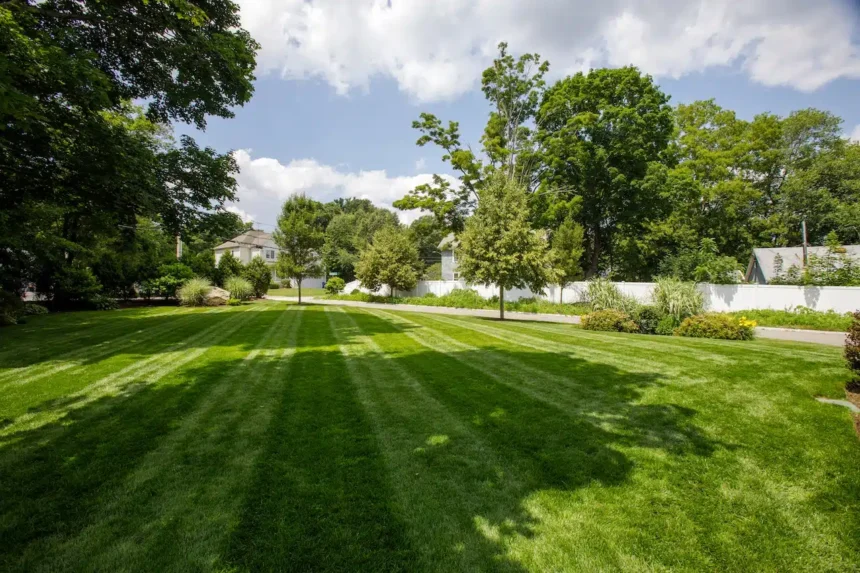Each season brings unique challenges and opportunities for lawn and tree care. Whether you’re looking to keep your grass lush or ensure your trees stay strong and healthy, a seasonal care routine is essential. By planning ahead, homeowners can maintain a beautiful and resilient landscape year-round, making sure that their lawn and trees get the attention they need when it matters most.
For those who want professional guidance, Habitat Pest & Lawn offers expert services that address seasonal requirements, helping your lawn and trees thrive in every season. Here’s a comprehensive seasonal checklist to guide you through lawn care, tree care, and pest control throughout the year.
Spring: Prepare for Growth
Spring is all about preparing your lawn and trees for the active growing season. This is the time to clean up winter debris, nourish the soil, and get your plants ready for warmer weather.
Spring Lawn Care
- Rake and Remove Debris: Rake the lawn to remove dead grass, leaves, and winter debris that can block sunlight and hinder growth.
- Aerate the Soil: Aeration loosens compacted soil, allowing roots to access air, water, and nutrients. Aerating in spring helps grass grow deeper roots.
- Apply Fertilizer: Use a slow-release fertilizer to provide essential nutrients for your lawn’s growth. Make sure the fertilizer is appropriate for your grass type.
- Spot-Treat Weeds: Spring is the perfect time to apply pre-emergent herbicides to prevent weeds from sprouting. This keeps your lawn looking clean and healthy throughout the season.
Spring Tree Care
- Inspect for Damage: Winter weather can cause broken branches. Trim damaged or dead branches to encourage healthy growth and prevent pest infestation.
- Add Mulch Around Trees: Apply a layer of mulch around the base of each tree, but avoid piling it against the trunk. Mulch helps retain moisture and regulate soil temperature.
- Water Young Trees: As temperatures rise, young trees need consistent watering. Deeply water newly planted trees to encourage strong root development.
Spring preparation sets the stage for a healthy, vibrant landscape that’s ready for the growing season ahead.
Summer: Maintain and Protect
Summer brings heat, increased growth, and pests. This season requires diligent lawn care and tree maintenance to keep your landscape in optimal condition, even during the hottest months.
Summer Lawn Care
- Water Deeply and Early: Watering in the morning reduces evaporation, allowing grass to absorb moisture. Aim to water deeply but infrequently to promote deep root growth.
- Mow Regularly: Keep grass at a slightly higher height to provide shade to the roots, reducing water loss. Follow the one-third rule: never cut more than one-third of the grass blade height.
- Watch for Pests: Lawn pests like grubs can damage grass roots. Look for signs of browning or irregular patches, and consider targeted pest control if needed.
- Fertilize Warm-Season Grasses: For warm-season grasses, summer is the peak growing period. Apply a balanced fertilizer to support growth, but avoid fertilizing during extreme heat.
Summer Tree Care
- Water Consistently: Mature trees may need supplemental watering during dry spells. Water deeply to ensure moisture reaches the root zone, particularly for trees less than three years old.
- Prune Wisely: Remove any dead or diseased branches, but avoid heavy pruning in the summer. Too much pruning can stress trees and make them vulnerable to pests.
- Inspect for Pests and Disease: Monitor trees for signs of pests like caterpillars or disease. Catching issues early allows for timely treatment, preventing the spread of damage.
Summer maintenance keeps your lawn green and your trees healthy, even under challenging conditions.
Fall: Prepare for Dormancy
Fall is a transition season, preparing your landscape for winter dormancy. Cooler temperatures and lower growth rates make this an ideal time for certain lawn and tree care tasks that support long-term health.
Fall Lawn Care
- Aerate and Overseed: Aerate to relieve soil compaction, then overseed to fill in bare patches. This strengthens the lawn, ensuring it grows back thicker in spring.
- Fertilize Cool-Season Grasses: Fall is the perfect time to fertilize cool-season grasses, like fescue and bluegrass. Fertilizing now promotes root development over the winter.
- Mow One Last Time: Keep mowing until the grass stops growing. For the final mow, set your mower slightly lower to avoid matting.
- Remove Fallen Leaves: Leaves block sunlight and trap moisture, creating an environment for mold growth. Regularly remove fallen leaves to keep the lawn healthy.
Fall Tree Care
- Mulch for Winter Protection: Add a fresh layer of mulch around the base of trees to protect roots from cold temperatures and reduce soil moisture loss.
- Prune Dead Branches: Remove any dead or weakened branches that could break during winter storms. This also reduces the risk of disease.
- Protect Against Pests: Some pests burrow into tree bark to overwinter. Applying tree wraps or protective barriers can prevent infestations during winter dormancy.
Fall preparation ensures your lawn and trees have the strength to withstand the colder months, emerging healthier in spring.
Winter: Minimal Maintenance with Key Protection
Winter is a time of dormancy for most plants, but a few steps can help protect your lawn and trees until the weather warms up again. Although active maintenance is limited, proactive protection can prevent winter damage.
Winter Lawn Care
- Limit Foot Traffic: Avoid walking on frozen grass to prevent breaking or damaging grass blades. Excessive foot traffic can lead to compacted soil and patchy areas.
- Clear Snow Promptly: Shovel snow from high-traffic areas but avoid piling it onto the lawn. Excessive snow on grass can cause mold growth.
- Avoid Salt Damage: If you use salt to melt ice, keep it away from your lawn. Salt can harm grass and soil, leading to brown patches in spring.
Winter Tree Care
- Inspect for Ice Damage: Heavy snow and ice can break branches. After a storm, gently remove excess snow from branches to prevent damage.
- Protect Young Trees: Young trees are particularly vulnerable to cold temperatures. Consider wrapping trunks to prevent frost cracks and sunscald.
- Watch for Wildlife Damage: Rodents and deer sometimes feed on tree bark during winter. Wrapping the lower trunk can deter animals and prevent bark damage.
Winter protection is a simple but essential part of ensuring your landscape’s health and longevity through the coldest months.
Conclusion: Year-Round Care for a Thriving Landscape
A beautiful, thriving landscape doesn’t happen by chance—it’s the result of consistent, seasonal care that addresses the specific needs of each season. From spring growth preparation to winter protection, each season brings opportunities to nurture your lawn and trees, ensuring they remain strong, green, and healthy throughout the year. For those seeking professional assistance, Habitat Pest & Lawn provides tailored lawn and tree care services that address the unique challenges of each season, creating a stunning landscape that flourishes year-round.
With this seasonal checklist as a guide, homeowners can stay on top of essential lawn and tree care tasks, enjoying a beautiful and resilient outdoor space in every season. By investing in seasonal care, you create a landscape that enhances the value of your property and provides a welcoming environment for family and friends.


